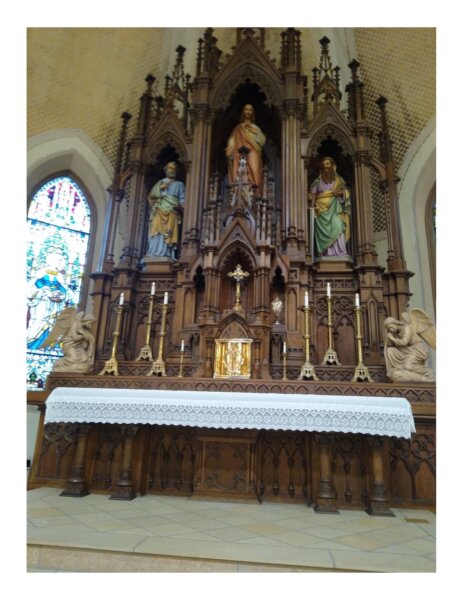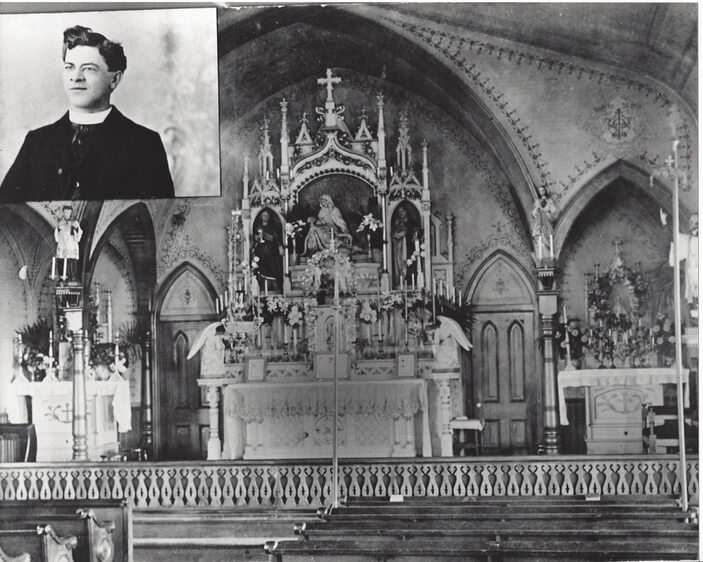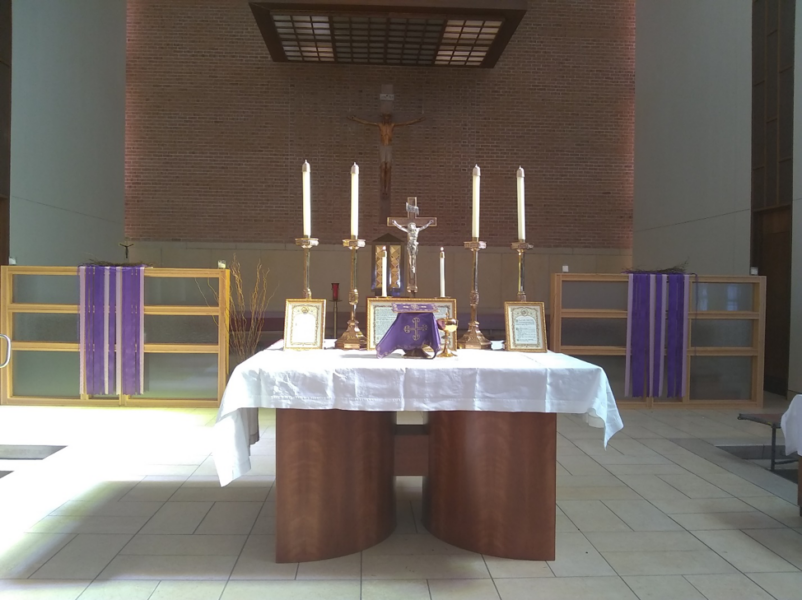Above: Winona, Minnesota, part of the diocese of Winona-Rochester.
The Latin Mass of my youth, I remember well. Although, I was only 5 to 8 years old, I could detect the reverence of the priests and parishioners; after Mass, I would set up a home altar and try, as best I could, to replicate the reverence and solemn movements of the priest at the altar, my back turned from the few friends who would act as parishioners.
When the Novus Ordo First Appeared
Although the TLM formed my reverence towards the holy Eucharist and the Blessed Sacrament, I nevertheless transitioned with relative ease to the Novus Ordo mass, without experiencing any kind of noticeable spiritual impoverishment; I was ten years old. In fact, I did not feel, early on, throughout the early 1970s anything troubling. The New Mass, celebrated reverently, along with a pastoral directive to embrace the Sacrament of Confession, go to adoration and daily Mass (if possible), and certainly Sunday Mass, fit within a Catholicity that made sense to me and answered my spiritual needs.
It did not take long however for the glorious Gregorian chant to give way to guitars and religious folk singing in the sanctuary in the revised rites. At first, as I was growing through adolescence, I thought the music was engaging and cool, something new that brought relevance to a youth caught in the throes of both a sexual and music revolution.
But after I turned eighteen, I began to lose interest in things like daily Mass and Confession; a certain disorder entered into my life as my appreciation for loud rock & roll music and violent movies crept into my taste preferences. Meanwhile, the Mass had lost its mystery; it could not draw me into a deeper introspection, a quieting of the senses now heavily stimulated by the world’s noises, its poisonous whispers.
Diminishing Reverence
Strangely, the church structure had changed: no altar railing clearly defining the sanctuary, delineating the Holy of Holies, the King of Kings, the One to Whom every knee in heaven, on earth and in the netherworld shall bend. The altar boy no longer placed the patent under the chin at the reception of the Eucharist, and in fact, an altar boy no longer needed to follow the priest during Holy Communion as the faithful lined up for reception in the hand.
There arose from these practices a subtle but real diminishment of the sacred and holy. And so, anyone and everyone walked through the sanctuary willy-nilly or could distribute Holy Communion; they were irreverent and seemingly ignorant of the Great King radiating from the tabernacle. The mystical had been lost, the supernatural swept away, leaving room for a more a pedestrian-like parishioner, happy with the catchy music, and the donuts after Mass.
Thanks be to God, I stayed in the Church as a regular Mass-goer. But it was hard.
Encountering Beauty Himself
As a married professional with children, many decades later, I attended a TLM mass at our parish one Saturday afternoon. It was part of a diocesan experiment, which several parishioner from another Catholic church had requested. The Most Reverend Bishop Harrington had granted an “indult,” although within the year, an “indult” was not necessary, due to Summorum Pontificum of Pope Benedict XVI. Beauty is what came to strike my heart at the first TLM; “where has beauty been all of these years?” I asked myself interiorly, immersed in the beautiful cantillation of the priest singing “Dominus Vobiscum,” the syllabic chant of the Gloria, and the neumatic chant of the Kyrie and the Sanctus, giving order and calm to my rather unsettled soul.[1]
Kneeling before the high altar, I understood something of the majesty and kingship of Jesus Christ, as the priest, wearing the old vestments, moved towards the high altar, interceding on our behalf to God, begging for mercy:
O Lord, hear my prayer.
And let my cry come unto Thee.
Show us, O Lord, Thy mercy.
And grant us Thy salvation.


I understood for the first time the intercessory role of the priest. Contrition and thanksgiving, I deeply felt. But it was particularly the melismatic chants that immersed me in the ethereal, possibly engaging me in the sublime.[2] I could only conclude that I was in the proximity of Beauty Himself.
This was something that I intuitively understood by experiencing God in the Latin Mass. It was only later that I began to read and study and understand more of what was happening.
The Vital Importance of Chant
Fr. Ripperger, in extolling the role of Gregorian chant in settling the mind and heightening man’s ascendency towards God, defends its simplicity as God-like and thus eagerly embraced by man who earnestly seeks God.
Fr Ripperger claims that classical Gregorian chant “has an ordering effect on the higher faculties of man towards God.” He advances that Gregorian chant helps the faithful orient their thoughts towards the things of God; thus it has an inherent ordering effect in the Sacred Liturgy, which cannot be achieved with guitars and folk songs, which are bound to an egocentric world view. Conversely, Gregorian chant assists man towards sanctified perfection or holiness; in the context of the holy mass, the faithful can undergo the process of deification and so it is vital that right order be present in the Mass, and from this order, beauty can facilitate man’s ascendency, his union with God. Ray Sullivan writes that,
the more sanctifying grace we receive, the more like God we become. We get this sanctifying grace as a free-gift when we receive the sacraments and attend Mass. And since the Mass is the holiest of all prayers here on earth, it is where we receive the MOST grace.
The holiness of Mass should be reflected in the beauty of Mass.
Where Has All the Beauty Gone?
I searched for answers. I read about the effects of the French and Industrial Revolutions which eroded beauty in culture and society. The corrosion of this idea of beauty, took place in concert with a generalized questioning of all of the transcendental values: beauty, goodness and truth.[3] Universally extolled by classical philosophers, beauty, says Plato, “gives the soul wings.” This makes sense, if one accepts the philosophical tenant that when truth and goodness unite, there in its midst is beauty.[4] Following that logic, one can posit that when a society begins to reject, relativize truth and goodness, beauty’s erosion follows quickly, slowly redefining societies, as they purge from their public squares, political parties, tribunals, and governmental legislatures, the longstanding transcendental values of Western societies. The consequence is that we end up living in a society that no longer extols beauty.
All this made sense to me. The Novus Ordo, much like most of society, reflected this loss of beauty, reverence and order, all traits needed for the settling of souls immersed in a chaotic world.
But thank God we had the Latin Mass. Thank God my family and I had found this Mass for it pointed us towards Beauty Himself. Thank God Bishop Harrington had granted an indult in the first place.
Enter Bishop Barron
When Bishop Barron was appointed to our diocese, he did nothing to change our Latin Mass. He himself wrote in praise of the Latin Mass as was mentioned previously on OnePeterFive:
The reverential language of the liturgy, for instance, convinces us that ‘all easy familiarity’ is inappropriate in regard to God[.] …The radical theocentrism of the liturgy teases us sinners out of our native egocentrism and thereby prepares us to see even created values with fresh eyes.[5]
Bishop Barron’s critique of “easy familiarity” – in a forward to a book about the Latin Mass – was exactly what I had experienced in my life. There was reverence and beauty in the Latin Mass of my youth, but then the “reverential language” was removed in the folk singing of the New Rite. When I rediscovered the TLM, I rediscovered that “radical theocentrism” of Beauty Himself.
In Traditionis Custodes, Pope Francis says the Latin Mass can no longer use a parish church. This is certainly consistent with what the secular society is doing by purging beauty from our midst. Recently, my wife and I received notification that our TLM would be moved to the local Catholic high school chapel. Goodbye, Beauty Himself at the high altar. Hello, gym-like altar:

The beautiful setting is lost.
This started Sunday, February 26. It was a directive given by Bishop Barron. His authority to manage the TLM in his diocese, now usurped by the Pope, left this poor bishop with tied hands. The US bishops have effectively lost all ability to manage the question of TLM masses in their respective dioceses. The Pope later made it clear that all diocesan requests to continue with the TLM had to be submitted to Rome.
What were we to do?
As I contemplated what it would be like to leave my parish of seventeen years to attend a TLM Mass, leaving behind the beauty of our high altar, and ultimately abandoning the parish community, I painfully conceded that I had to consider abandoning the TLM and attending the parish Novus Ordo mass next Sunday. I suppose that was the Pontiff’s plan all along. But my great hunger for beauty, and the order that comes with the Latin Mass, drew me to choose that high school chapel, as I attempted to find appeasement of that hunger.
So we offer up our Latin Mass in the most beautiful way we can, seeking to know Beauty Himself, even in a modernly recovated gym-like high school chapel.
NOTES
Cantillation: Recto tono, recitation of text on a tone. Jewish roots of needing to elevate the singing of Scripture and Temple/Synagogue Worship. Examples for us are Orations, Readings, Responses: “Dominus Vobiscum”
Syllabic Chant: one note per syllable. Examples are Gloria, Credo
Neumatic Chant: 2-4 notes per syllable. Examples are Sanctus, Kyrie, Introit, Communion chants. These were developed by elaborating on the psalm tones, matched to their 8 church modes. They were embellished to better fit the larger Liturgical processions around the 5-7th centuries when larger basilicas were built.
Melismatic Chant: Multiple notes per syllable. Truly allow one to meditate on the Scripture and beauty. Examples are the Gradual, Alleluia, and Offertory chants. I would also place high polyphony into this “category” as the highest expression of praise to Almighty God.
[1] Ripperger, C. (2022). “The effects of Gregorian Chant in the Spiritual Life,” The 2022 International Chant Conference.
[2] Ibid.
[3] Baldwin, JM. (2015). Genetic Theory of Reality. New York: Putman’s
[4] Harden, J. (1980). Modern Catholic Dictionary. New York,NY: Image Books
[5] Bishop Robert Barron, “Forward,” Dietrich von Hildebrand, Liturgy and Personality (The Hildebrand Project, 2016), xvi, xvii.


